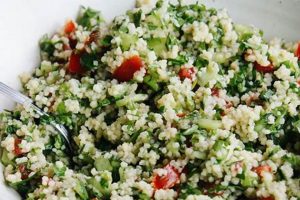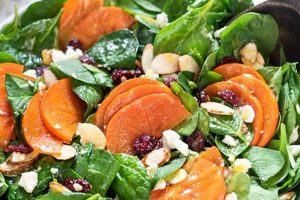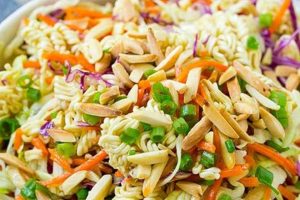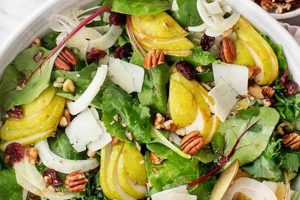A superior cornbread salad typically combines crumbled cornbread with fresh vegetables like tomatoes, cucumbers, onions, and bell peppers. Often, black beans or corn kernels are added for extra texture and flavor. A vinaigrette dressing, sometimes incorporating buttermilk or sour cream, binds the ingredients together. Variations may include bacon, cheese, jalapenos, or other herbs and spices, creating diverse flavor profiles. A well-executed version offers a balance of sweet, savory, crunchy, and creamy elements.
This dish is a popular choice for potlucks, picnics, and barbecues due to its make-ahead convenience and refreshing nature. It showcases the versatility of cornbread, transforming it from a simple side into the star of a vibrant salad. The adaptability of the recipe allows for customization based on seasonal ingredients and personal preferences, making it a perennial favorite. Its historical roots likely lie in the Southern United States, where cornbread is a staple, and resourcefulness led to creative uses of leftover bread.
The following sections will delve into specific variations, including classic Southern versions, Southwestern-inspired options with a spicy kick, and lighter variations featuring fresh herbs and lemon vinaigrette. Tips for achieving perfectly crumbled cornbread and balancing flavor profiles will also be explored.
Tips for an Exceptional Cornbread Salad
Achieving a truly outstanding cornbread salad requires attention to detail. These tips offer guidance for optimizing flavor and texture, ensuring a delightful culinary experience.
Tip 1: Cornbread Selection: Opt for a slightly sweet, preferably homemade, cornbread. A denser texture holds up better than a crumbly one. Consider using buttermilk for a tangy flavor that complements the other ingredients.
Tip 2: Crumbling Technique: Allow the cornbread to cool completely before crumbling. Aim for a variety of sizes, from coarse crumbs to finer pieces, for textural interest. Avoid over-crushing, which can lead to a mushy salad.
Tip 3: Vegetable Freshness: Utilize ripe, in-season vegetables for optimal flavor and crispness. Thoroughly dry the vegetables after washing to prevent a watery salad.
Tip 4: Dressing Balance: The vinaigrette should complement the cornbread and vegetables without overpowering them. A balance of acidity, sweetness, and savory notes is key. Taste and adjust seasonings as needed.
Tip 5: Ingredient Incorporation: Gently combine the ingredients to avoid breaking down the vegetables or over-softening the cornbread. Add the dressing just before serving to maintain the salad’s texture.
Tip 6: Chilling Time: Allowing the salad to chill for at least 30 minutes before serving allows the flavors to meld and enhances the overall experience. However, avoid excessive chilling, as this can dull the flavors of fresh vegetables.
Tip 7: Garnishing and Serving: Enhance visual appeal and flavor with fresh herbs, such as chopped chives or parsley. Consider a sprinkle of crumbled bacon or cheese for added richness. Serve chilled in a large bowl or individual portions.
By following these guidelines, one can elevate a simple cornbread salad into a culinary masterpiece. The combination of fresh ingredients, balanced flavors, and thoughtful preparation guarantees a satisfying and memorable dish.
In conclusion, a carefully crafted cornbread salad offers a delightful combination of textures and flavors. By understanding the nuances of ingredient selection, preparation, and presentation, one can create a truly exceptional dish.
1. High-quality Cornbread
High-quality cornbread serves as the cornerstone of a successful cornbread salad. Its texture, flavor profile, and structural integrity significantly influence the final dish. Selecting or preparing the right cornbread is paramount to achieving a desirable outcome.
- Texture and Density:
The ideal cornbread possesses a slightly dense, moist crumb. This texture absorbs the dressing without becoming soggy, maintaining a pleasant mouthfeel within the salad. Overly dry or crumbly cornbread disintegrates easily, leading to a mushy texture. Conversely, excessively dense cornbread can feel heavy and detract from the other ingredients. A balanced texture ensures the cornbread contributes to, rather than detracts from, the overall salad experience. Examples include cornbread made with buttermilk or sour cream, which contribute to a desirable moisture level and a slightly tangy flavor that complements the vegetables and dressing.
- Sweetness Level:
Cornbread sweetness plays a crucial role in balancing the salad’s flavor profile. A slightly sweet cornbread complements the savory vegetables and tangy dressing. Excessively sweet cornbread can clash with these elements and create an unbalanced flavor profile. Traditional Southern-style cornbread, with its moderate sweetness, typically works well. Adjusting sugar levels in homemade recipes allows for customization based on personal preferences and other salad components.
- Ingredient Quality:
The quality of ingredients used in the cornbread directly impacts its flavor and texture. Using fresh, high-quality cornmeal, along with other premium ingredients like buttermilk and butter, yields superior results. Freshly ground cornmeal offers a more pronounced corn flavor, enhancing the overall dish. Conversely, lower-quality ingredients can result in a bland or unappetizing cornbread that detracts from the salad.
- Baking Technique:
Proper baking techniques are essential for achieving the desired texture and consistency. Overbaking results in dry, crumbly cornbread, while underbaking leads to a gummy texture. Baking at the correct temperature for the appropriate time ensures a perfectly cooked cornbread with a moist crumb and a slightly crisp exterior, ideal for incorporating into a salad. Evenly distributing batter in the baking pan ensures consistent cooking throughout.
These facets of high-quality cornbread collectively contribute to the overall success of the cornbread salad. By carefully considering texture, sweetness, ingredient quality, and baking technique, one ensures that the cornbread complements and enhances the other components, creating a balanced and flavorful dish.
2. Fresh, Seasonal Vegetables
The incorporation of fresh, seasonal vegetables is integral to achieving a superior cornbread salad. These vegetables contribute not only vibrant color and textural contrast but also crucial flavor dimensions that elevate the dish beyond the ordinary. Seasonality ensures optimal flavor and nutritional value, as vegetables harvested at their peak ripeness possess a depth of flavor often lacking in out-of-season produce. The inherent sweetness of ripe summer tomatoes, the crispness of freshly picked cucumbers, and the peppery bite of in-season bell peppers harmonize with the savory cornbread, creating a complex and satisfying flavor profile. For example, a summer cornbread salad might feature ripe tomatoes, cucumbers, and sweet corn, while an autumn version could showcase roasted butternut squash, Brussels sprouts, and cranberries.
This emphasis on fresh, seasonal produce also allows for greater flexibility and creativity within the recipe. Adapting the vegetable components based on seasonal availability allows for ongoing exploration of flavor combinations and ensures access to the most vibrant, flavorful ingredients. Furthermore, the use of fresh vegetables aligns with contemporary culinary trends that prioritize healthy, locally sourced ingredients. This commitment to quality ingredients not only enhances flavor but also provides a greater nutritional benefit. The inclusion of these ingredients underscores the versatility of cornbread salad and its adaptability to diverse culinary preferences and dietary considerations.
Ultimately, the selection of fresh, seasonal vegetables represents a critical element in crafting an exceptional cornbread salad. It demonstrates an understanding of the interplay between flavor, texture, and seasonality, crucial for elevating the dish from simple fare to a culinary highlight. Choosing produce at its peak ripeness guarantees optimal flavor, nutritional value, and visual appeal, all contributing to a truly satisfying and memorable culinary experience. This awareness underscores the importance of considering each component’s impact on the final product and how thoughtful ingredient selection contributes to an overall superior dish.
3. Balanced, flavorful dressing
A balanced, flavorful dressing is paramount in achieving a superlative cornbread salad. The dressing serves as the unifying element, binding the diverse components and harmonizing their individual flavors. It provides essential moisture and enhances the overall sensory experience. A well-crafted dressing elevates the dish beyond a simple combination of ingredients, transforming it into a cohesive, flavorful whole. The balance refers to a harmonious interplay of acidity, sweetness, and savory notes. An overly acidic dressing can overwhelm the other flavors, while excessive sweetness can clash with the savory elements of the cornbread and vegetables. A successful dressing complements, rather than dominates, the other components, enhancing their inherent qualities.
For instance, a classic vinaigrette, often employed in cornbread salad, typically combines vinegar, oil, and seasonings. The vinegar provides the necessary acidity, while the oil contributes richness and texture. The choice of oil influences the flavor profile; a robust olive oil lends a peppery note, while a neutral oil like canola allows the other flavors to shine. Seasonings, such as herbs, spices, and sweeteners, further enhance complexity and depth. A touch of Dijon mustard can add a subtle tang, while a pinch of sugar balances the acidity. The specific combination of ingredients and their proportions determine the dressing’s overall character and its impact on the final dish. A Southwestern-inspired cornbread salad might benefit from a lime-cilantro vinaigrette, while a more traditional version might feature a buttermilk-based dressing. The dressing’s flavor profile should complement the other ingredients, creating a synergistic blend.
Understanding the crucial role of a balanced, flavorful dressing is essential for crafting an exceptional cornbread salad. It underscores the importance of considering the interplay of flavors and how each component contributes to the overall culinary experience. A well-executed dressing elevates the dish, transforming it from a simple combination of ingredients into a cohesive and satisfying culinary creation. The careful selection of ingredients and the precise balance of flavors within the dressing ultimately determine the success of the cornbread salad, highlighting the importance of this often-overlooked component.
4. Proper Ingredient Proportions
Achieving a “best cornbread salad recipe” designation hinges significantly on proper ingredient proportions. Balance among components is crucial; an excess of one ingredient can overwhelm the others, while too little can leave the dish lacking depth and complexity. Careful consideration of ingredient ratios ensures a harmonious blend of flavors and textures, crucial for an optimal culinary experience. This section explores key facets of ingredient proportioning within a cornbread salad.
- Cornbread-to-Vegetable Ratio:
The ratio of cornbread to vegetables significantly impacts the salad’s overall character. Too much cornbread can result in a dry, heavy salad, while an abundance of vegetables might dilute the cornbread’s contribution. A balanced ratio allows both elements to shine. A general guideline suggests a slightly higher proportion of vegetables to cornbread, ensuring a refreshing, vibrant salad. However, specific ratios may vary depending on the chosen vegetables and desired texture.
- Dressing Quantity:
The amount of dressing directly influences the salad’s moisture level and flavor intensity. Too much dressing creates a soggy, heavy salad, while too little leaves it dry and unappetizing. The ideal amount coats the ingredients evenly without overpowering them. The dressing should enhance, not mask, the flavors of the cornbread and vegetables. The target consistency is a lightly coated salad, not a drenched one. The absorption rate of the cornbread and the types of vegetables used influence the appropriate dressing quantity.
- Add-in Proportions:
Additional ingredients, such as cheese, bacon, jalapenos, or herbs, contribute complexity and textural interest. However, these additions should be incorporated judiciously. Overdoing add-ins can create a cluttered flavor profile and overwhelm the core ingredients. A restrained approach ensures that these elements enhance, rather than dominate, the salad. Consider the intensity of each add-in’s flavor when determining its proportion. For example, a small amount of a strong cheese like blue cheese may have as much impact as a larger quantity of a milder cheese like cheddar.
- Balancing Flavor Profiles:
Ingredient proportions contribute significantly to balancing flavor profiles. The sweetness of the cornbread, the acidity of the dressing, the savory notes of the vegetables, and the intensity of any add-ins must harmonize. A skewed proportion can lead to a dish that is overly sweet, excessively tangy, or bland. Careful consideration of each ingredient’s flavor profile and its interaction with other components is crucial for achieving balance. Taste-testing throughout the preparation process allows for adjustments and ensures a harmonious final product.
Ultimately, achieving the “best cornbread salad recipe” requires a nuanced understanding of ingredient proportions and their impact on the final product. Careful balancing of cornbread, vegetables, dressing, and add-ins ensures a harmonious blend of flavors, textures, and aromas, creating a truly exceptional culinary experience. Attention to these details distinguishes a well-executed cornbread salad from a mediocre one.
5. Appropriate Chilling Time
Appropriate chilling time plays a crucial role in achieving a “best cornbread salad recipe” designation. Chilling allows the flavors of the various componentscornbread, vegetables, dressing, and any add-insto meld and harmonize, resulting in a more cohesive and nuanced flavor profile. However, excessive chilling can have detrimental effects, potentially dulling the flavors of fresh vegetables or making the cornbread overly dense. This section explores the optimal chilling time for cornbread salad and its impact on the final product.
- Flavor Development:
Chilling allows the dressing to permeate the cornbread and vegetables, distributing flavors evenly throughout the salad. This melding of flavors creates a more complex and balanced taste profile, as individual components harmonize into a cohesive whole. The chilling process allows the subtle nuances of each ingredient to emerge and interact, enhancing the overall culinary experience. For instance, the sweetness of the cornbread can balance the acidity of the dressing, while the savory notes of the vegetables can deepen and intensify.
- Texture Optimization:
Chilling firms the vegetables, maintaining their crispness and preventing them from becoming soggy. The cornbread also benefits from chilling, developing a slightly denser texture that holds its shape better when mixed with the other ingredients. This textural contrast between the crisp vegetables and the slightly firm cornbread enhances the overall enjoyment of the salad. However, prolonged chilling can make the cornbread excessively dense and the vegetables lose their desirable crunch.
- Temperature Considerations:
Serving cornbread salad chilled enhances its refreshing qualities, particularly during warmer months. A cool salad offers a welcome contrast to hot weather and provides a light, satisfying meal. However, serving the salad excessively cold can numb the palate and diminish the perception of subtle flavors. The ideal temperature balances refreshment with optimal flavor perception.
- Recommended Chilling Time:
The optimal chilling time for cornbread salad generally falls between 30 minutes and 2 hours. This timeframe allows sufficient time for flavor development and texture optimization without compromising the quality of the ingredients. Extending beyond this window risks over-chilling, which can dull flavors and alter textures negatively. Shorter chilling periods may not allow sufficient time for flavors to meld fully.
In conclusion, appropriate chilling time is integral to achieving a “best cornbread salad recipe.” It allows flavors to meld, textures to optimize, and the salad to reach an ideal serving temperature. Adhering to the recommended chilling timeframe ensures a balanced and refreshing dish that showcases the harmonious interplay of ingredients. Understanding this crucial step elevates cornbread salad from a simple side dish to a culinary centerpiece.
6. Creative additions (optional)
While a classic cornbread salad thrives on the foundational elements of cornbread, fresh vegetables, and a balanced dressing, creative additions can elevate the dish to new heights. These additions, while optional, offer opportunities to introduce nuanced flavors, textures, and visual appeal, transforming a simple salad into a culinary masterpiece. The connection between creative additions and a “best cornbread salad recipe” lies in their capacity to enhance and personalize the dish, catering to specific palates and dietary preferences. Consider the impact of incorporating elements such as grilled corn kernels, which introduce a smoky sweetness and satisfying texture. Alternatively, crumbled bacon adds a salty, savory dimension, while diced avocado contributes creaminess and healthy fats. Black beans or chickpeas enhance protein content and provide textural contrast. These additions exemplify how thoughtful inclusions can transform a standard recipe into an exceptional one.
The judicious use of herbs and spices further exemplifies the power of creative additions. Fresh cilantro and lime zest brighten the flavor profile, while a pinch of chili powder introduces a subtle warmth. Chopped chives or parsley add a fresh, herbaceous note. Even the choice of cheese can significantly impact the overall experience. Feta cheese contributes a salty tang, while crumbled goat cheese offers a creamy, earthy flavor. These examples illustrate how even small additions can significantly impact the final product. Moreover, creative additions offer an avenue for incorporating seasonal ingredients. Roasted butternut squash in the fall, fresh berries in the summer, or pomegranate seeds in the winter provide unique seasonal flavors that keep the salad interesting throughout the year. This adaptability highlights the versatility of cornbread salad and its potential for continuous culinary exploration.
However, the key to successful creative additions lies in restraint and balance. Overly enthusiastic additions can overwhelm the core components, creating a muddled flavor profile. The objective is to enhance, not overshadow, the foundational elements. Careful consideration of flavor combinations and textural contrasts ensures that each addition contributes positively to the overall dish. Therefore, achieving a “best cornbread salad recipe” through creative additions requires a nuanced understanding of flavor profiles and the ability to incorporate these elements judiciously. This delicate balance distinguishes a truly exceptional cornbread salad from a merely adequate one, demonstrating a mastery of culinary technique and an appreciation for the transformative power of thoughtfully chosen ingredients.
Frequently Asked Questions
This section addresses common inquiries regarding optimal cornbread salad preparation, offering insights and guidance for achieving exceptional results.
Question 1: Can cornbread salad be prepared in advance?
Yes, cornbread salad benefits from advance preparation. Making the salad a day ahead allows the flavors to meld. However, add the dressing just before serving to prevent the salad from becoming soggy.
Question 2: What type of cornbread works best for this salad?
Slightly sweet, dense cornbread holds up best. Buttermilk cornbread adds a pleasant tang. Avoid overly crumbly or dry cornbread.
Question 3: How can sogginess be prevented?
Thoroughly dry vegetables after washing. Add the dressing immediately before serving. Avoid over-dressing the salad.
Question 4: Can alternative grains be used instead of cornbread?
While not traditional, crumbled biscuits or croutons can substitute for cornbread. However, this alters the flavor profile significantly.
Question 5: How should leftover cornbread salad be stored?
Store leftover salad in an airtight container in the refrigerator for up to three days. The texture may soften slightly over time.
Question 6: Can frozen corn be used?
Fresh corn offers superior flavor and texture. If using frozen corn, thaw and thoroughly drain before adding to the salad.
Careful attention to these considerations ensures a successful and flavorful cornbread salad. Understanding the nuances of preparation allows for customization and consistent positive results.
For further exploration, the following section delves into specific variations of cornbread salad, offering inspiration and guidance for customizing this versatile dish.
Best Cornbread Salad Recipe
Achieving a truly exceptional cornbread salad requires a nuanced understanding of its core components. From the selection of a perfectly textured cornbread to the incorporation of fresh, seasonal vegetables, each element contributes significantly to the final product. A balanced, flavorful dressing unites these components, while proper ingredient proportions and appropriate chilling time ensure a harmonious blend of flavors and textures. Creative additions, when implemented judiciously, further enhance the salad’s complexity and appeal, transforming it from a simple side dish into a culinary centerpiece. Careful consideration of these factors distinguishes a “best cornbread salad recipe” from a merely satisfactory one.
The pursuit of the best cornbread salad recipe represents a continuous journey of culinary exploration. Adaptability and a willingness to experiment with flavors and textures pave the way for innovative variations that cater to diverse palates and preferences. By embracing seasonality, prioritizing fresh ingredients, and understanding the delicate interplay of components, one can consistently achieve a cornbread salad that delights the senses and exemplifies culinary excellence. This pursuit underscores the enduring appeal of this versatile dish and its potential for continued culinary innovation.






